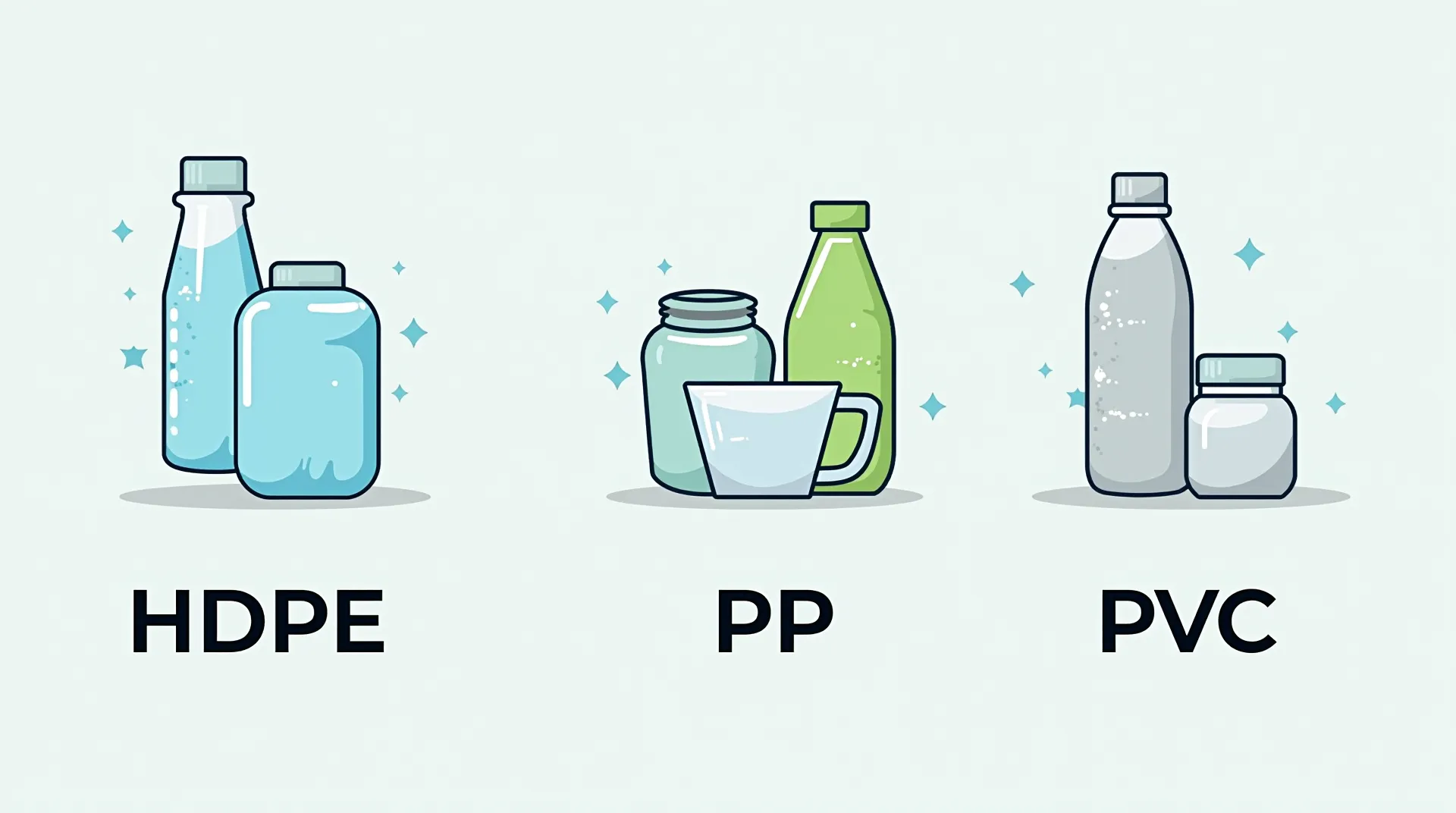Stijve kunststoffen zijn fundamentele materialen in een groot aantal industrieën en worden gewaardeerd om hun uitzonderlijke duurzaamheid, veelzijdigheid en productie-efficiëntie. Ze zijn essentieel voor talloze aspecten van het moderne leven, van alledaags gemak tot geavanceerde technologische ontwikkelingen. Deze verkenning richt zich op enkele van de meest voorkomende stijve kunststoffen, waaronder hogedichtheidspolyethyleen (HDPE), polypropyleen (PP) en polyvinylchloride (PVC), en beschrijft hun specifieke kenmerken en diverse toepassingen.
1. Hogedichtheidspolyethyleen (HDPE) – De sterke en betrouwbare keuze
Kerneigenschappen en voordelen:
- Hoge sterkte-dichtheidsverhouding: Biedt uitzonderlijke sterkte en is toch licht van gewicht. Het biedt een optimale balans voor dragende toepassingen.
- Uitstekende chemische bestendigheid: Het is uitstekend bestand tegen een breed scala aan oplosmiddelen, zuren en basen, waardoor het geschikt is voor chemisch veeleisende omgevingen.
- Superieure vochtbestendigheid: Absorbeert vrijwel geen water, waardoor het ideaal is voor vochtige omstandigheden of het verpakken van vloeistoffen.
- Duurzaam en slagvast: Door zijn robuuste karakter kan het grote schokken weerstaan zonder dat het snel scheurt of breekt.
Veelvoorkomende toepassingsgebieden:
- Containers en flessen: Onmisbaar voor alledaagse artikelen zoals melkkannen en wasmiddelflessen, gewaardeerd om hun veiligheid en betrouwbaarheid.
- Buizen en hulpstukken: Vanwege hun bewezen duurzaamheid worden ze veel gebruikt in loodgieters- en irrigatiesystemen.
- Kunststof hout: Wordt gebruikt voor tuinmeubilair, terrassen en speeltoestellen. Het is zowel esthetisch aantrekkelijk als weerbestendig.
- Kinderspeelgoed: Wordt vaak gekozen voor duurzaam speelgoed vanwege de hoge sterkte en niet-giftige eigenschappen.
2. Polypropyleen (PP) – De lichtgewicht en hittebestendige alleskunner
Kerneigenschappen en voordelen:
- Hoog smeltpunt: Geschikt voor toepassingen waarbij sprake is van hoge temperaturen, zoals magnetronbestendige voedselcontainers.
- Uitstekende vermoeidheidsweerstand: Kan herhaaldelijk buigen zonder te falen, zoals te zien is in scharnieren van flessendoppen.
- Brede chemische bestendigheid: Biedt effectief weerstand tegen veel voorkomende zuren, basen en organische oplosmiddelen.
- Lichtgewicht: Heeft een lagere dichtheid dan veel andere kunststoffen, wat zorgt voor lichtere eindproducten.
Veelvoorkomende toepassingsgebieden:
- Auto-onderdelen: Wordt gebruikt voor bumpers, batterijbehuizingen en interieurcomponenten, en biedt een effectieve balans tussen lichtgewicht design en duurzaamheid.
- Verpakking: Ideaal voor voedselcontainers, doppen en sluitingen, zorgt voor productveiligheid en hygiëne.
- Textiel: Het wordt toegepast in tapijten, meubelbekleding en non-wovens, wat de veelzijdigheid ervan illustreert.
- Medische hulpmiddelen: Wordt gebruikt in injectiespuiten en laboratoriumapparatuur en is geliefd vanwege de steriliseerbaarheid.
3. Polyvinylchloride (PVC) – Het veelzijdige en economische materiaal
Kerneigenschappen en voordelen:
- Veelzijdige mechanische eigenschappen: Kan, afhankelijk van de gebruikte additieven, stijf of flexibel worden gemaakt.
- Goede chemische bestendigheid: Bewijs van bestendigheid tegen zuren, basen en zouten.
- Effectieve elektrische isolator: Ideaal isolatiemateriaal voor diverse elektrische toepassingen.
- Duurzaam en langdurig: Biedt effectief weerstand tegen aantasting door de omgeving en garandeert een lange levensduur.
Veelvoorkomende toepassingsgebieden:
- Bouwmaterialen: Breed toegepast voor buizen, kozijnen en gevelbekleding vanwege de economische en praktische eigenschappen.
- Isolatie van elektrische kabels: Beschermt elektrische bedrading en verbetert de elektrische veiligheid.
- Medische hulpmiddelen: Wordt gebruikt voor bloedzakken, slangen en containers. Staat bekend om zijn veiligheid en betrouwbaarheid.
- Consumptiegoederen: Ze zijn te vinden in creditcards, speelgoed en diverse huishoudelijke artikelen, verkrijgbaar in verschillende vormen.
4. Polyethyleentereftalaat (PET/PETE) – De heldere en sterke verpakkingsster
Kerneigenschappen en voordelen:
- Hoge treksterkte: Combineert stevigheid met een licht gewicht, wat resulteert in robuuste en duurzame producten.
- Uitstekende barrière-eigenschappen: Biedt goede weerstand tegen gassen en vocht, cruciaal voor het behoud van de versheid in de verpakking.
- Zeer recyclebaar: Het is een van de meest gerecyclede kunststoffen en levert een aanzienlijke bijdrage aan de bescherming van het milieu.
- Transparante en glanzende afwerking: Biedt een esthetisch aantrekkelijke uitstraling voor verpakkingen en vergroot de aantrekkingskracht van het product.
Veelvoorkomende toepassingsgebieden:
- Drankflessen: Het meest gebruikte materiaal voor frisdrank- en waterflessen.
- Voedselverpakking: Wordt gebruikt voor trays, containers en clamshellverpakkingen en zorgt voor veiligheid en hygiëne.
- Textiel: Verwerkt tot polyestervezels voor kleding en bekleding.
- Elektronica: Wordt vanwege de isolerende eigenschappen toegevoegd aan componenten in elektronische apparaten.
5. Polystyreen (PS) – De expert in lichtgewicht en isolerende mallen
Kerneigenschappen en voordelen:
- Stijf en transparant: Meestal helder en hard, wat veel producten een aantrekkelijke visuele aantrekkingskracht geeft.
- Goede isolator: Biedt uitstekende thermische en elektrische isolatie.
- Gemakkelijk te vormen en te modelleren: Door de vormbaarheid is het geschikt voor het maken van ingewikkelde ontwerpen.
Veelvoorkomende toepassingsgebieden:
- Verpakkingsmaterialen: Inclusief schuimverpakking, wegwerpbestek en cd-hoesjes.
- Consumentenelektronica: Vormt behuizingen voor televisies, computers en apparaten.
- Medische apparatuur: Wordt gebruikt voor wegwerpartikelen, zoals injectiespuiten en laboratoriumcontainers.
- Speelgoed en modellen: Gekozen voor gedetailleerde en lichte objecten vanwege het gemak van het vormen.
6. Acrylonitril-butadieen-styreen (ABS) – De sterke en slagvaste technische kunststof
Kerneigenschappen en voordelen:
- Hoge slagvastheid: Uitzonderlijk sterk en bestand tegen fysieke schokken en stoten.
- Goede dimensionale stabiliteit: Behoudt effectief zijn vorm bij spanning en temperatuurschommelingen.
- Gemakkelijk te vormen en te bewerken: Maakt het mogelijk om complexe onderdelen nauwkeurig te vervaardigen.
- Glanzende afwerking: Kan worden geproduceerd met een hoogglansoppervlak, geschikt voor esthetisch aantrekkelijke producten.
Veelvoorkomende toepassingsgebieden:
- Auto-onderdelen: Omvat dashboardcomponenten, wieldoppen en interieurbekleding.
- Consumentenelektronica: Vormt duurzame behuizingen voor computers, printers en spelcomputers.
- Speelgoed: LEGO-stenen zijn een bekend voorbeeld van de toepassing van ABS in duurzaam speelgoed.
- Huishoudelijke apparaten: Wordt gebruikt in onderdelen voor stofzuigers, koelkasten en wasmachines.
7. Polycarbonaat (PC) – Het uitzonderlijk sterke, hoogwaardige materiaal
Kerneigenschappen en voordelen:
- Uitzonderlijke slagvastheid: Vrijwel onbreekbaar en biedt superieure bescherming, zelfs onder extreme omstandigheden.
- Hoge transparantie: Zorgt voor een helder, glasachtig uiterlijk.
- Hittebestendig: Bestand tegen hoge temperaturen zonder te vervormen.
- Goede elektrische isolator: Geschikt voor diverse elektronische toepassingen waarbij isolatie vereist is.
Veelvoorkomende toepassingsgebieden:
- Veiligheidsuitrusting: Wordt gebruikt in helmen, kogelwerend glas en beschermende schilden.
- Optische schijven: Het materiaal bij uitstek voor cd's, dvd's en Blu-ray-schijven.
- Auto- en lucht- en ruimtevaartcomponenten: Populair voor het creëren van lichte, maar toch sterke onderdelen.
- Elektronica: Kenmerken in smartphoneschermen, laptopbehuizingen en andere displayapparaten.
Snelle vergelijking van veelvoorkomende stijve kunststoffen
| Kunststof soort | Dichtheid (g/cm³) | Treksterkte (MPa) | Veelvoorkomende toepassingen |
| HDPE (Hogedichtheidspolyethyleen) | 0,93–0,97 | 20–37 | Flessen, pijpen, plastic hout |
| PP (Polypropyleen) | 0,90–0,92 | 30–50 | Auto-onderdelen, verpakkingen, textiel |
| PVC (Polyvinylchloride) | 1.16–1.58 | 50–60 | Buizen, elektrische isolatie, medische apparatuur |
| PET (Polyethyleentereftalaat) | 1.38–1.40 | 55–75 | Drankflessen, textiel, elektronica |
| PS (Polystyreen) | 1.04–1.06 | 30–50 | Verpakkingen, elektronicabehuizingen, speelgoed |
| ABS (Acrylonitril-butadieen-styreen) | 1.04–1.06 | 40–50 | Speelgoed, elektronica, auto-onderdelen |
| PC (Polycarbonaat) | 1.20–1.22 | 60–70 | Veiligheidsuitrusting, optische schijven, elektronica |
Let op: de opgegeven waarden zijn bij benadering en kunnen variëren afhankelijk van specifieke formules en productieprocessen.
Milieuoverwegingen: harde kunststoffen en een duurzame toekomst
Hoewel harde kunststoffen talloze voordelen bieden, is de impact op het milieu een belangrijke factor. We zetten ons in voor het bevorderen van duurzame ontwikkeling door middel van gerichte maatregelen:
- Verbetering van recyclebaarheid: Kunststoffen zoals PET en HDPE zijn zeer goed recyclebaar. We streven ernaar de recyclingefficiëntie te verbeteren en zo afval te verminderen en waardevolle grondstoffen te behouden.
- Productie optimaliseren: Wij zoeken voortdurend naar energiezuinigere en milieuvriendelijkere productieprocessen om de afhankelijkheid van niet-hernieuwbare hulpbronnen te verkleinen.
- Verantwoord afvalbeheer: Voor kunststoffen die lastig te recyclen zijn, zoeken we actief naar geschikte verwijderingsmethoden die de persistentie ervan in het milieu minimaliseren en ecosystemen beschermen.
Onze toewijding aan duurzame praktijken:
- Promotie van recyclingprogramma's: Wij stimuleren brede maatschappelijke deelname aan initiatieven voor het recyclen van hard plastic om gezamenlijk de belasting van het milieu te verminderen.
- Investeren in biologisch afbreekbare en innovatieve materialen: Wij richten ons op en investeren in onderzoek en ontwikkeling van biologisch afbreekbare kunststoffen en andere milieuvriendelijke alternatieven, waarbij we voortdurend op zoek zijn naar groenere materiaaloplossingen.
- Pleidooi voor rationeel gebruik: Wij promoten de keuze voor herbruikbare producten en minimaliseren het gebruik van wegwerpplastic. Daarmee willen we bijdragen aan de bescherming van het milieu bij de bron.
Conclusie: Slimme keuzes, samen de toekomst vormgeven
Van de veerkracht van HDPE tot de enorme sterkte van PC, elk type hard plastic vervult een cruciale rol in de moderne industrie en het dagelijks leven, gekenmerkt door zijn unieke eigenschappen. Een grondige kennis van hun eigenschappen en toepassingen stelt ons niet alleen in staat om weloverwogen materiaalkeuzes te maken die zijn afgestemd op specifieke behoeften, maar onderstreept ook het belang van het aanpakken van milieueffecten en het bevorderen van duurzame ontwikkeling. Door innovatief denken en een verantwoorde aanpak kunnen we gezamenlijk vormgeven aan een duurzamere en welvarendere toekomst.



